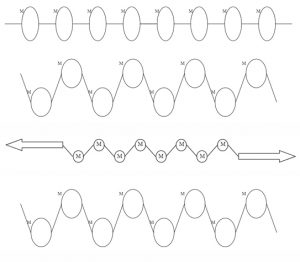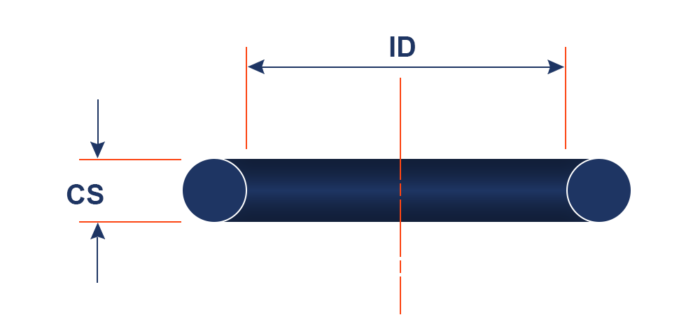O Ring Basics Handbook
Everything to know about O Rings
This is an O Ring Basics Handbook that will help you understand the fundamentals of O Ring Seals. Elastomers are different compared to any other material used by engineers. For example, plastic or metal components are most likely failing when visibly deformed. When it comes to an O Ring, in order for it to function properly, it must be deformed. As a matter of fact, an O Ring that is not stretched and squeezed is the wrong O Ring for an application.
Definition of an O Ring
An O Ring is a doughnut-shaped article, a closed circle usually made of elastomeric rubber. The O Ring seal’s purpose is to prevent an unwanted leakage or loss of gas or fluid, it is the most popular form of a seal.
Definition of an O Ring:
- Its dimensions – the inside diameter d1 and the cross-section d2
- Durometer (Shore A hardness)
- Material composition
The opposite faces of an O Ring are compressed between the faces of the gland. The consequent zero clearance within the gland guarantees an efficient seal, preventing the fluid or gas from flowing through the gland.
O Ring Manufacturing Processes
There are two standard manufacturing processes for the manufacture of rubber O Rings:
- Compression Moulding Process (CM process) – the material is manually placed into the mould prior to the upper and lower parts of the mould closing. This process is particularly suitable for larger dimensions and smaller quantities due to it being very time-consuming.
- Injection Moulding Process (IM process) – the material is automatically injected into the mould (tool), which has various O Ring cavities. It is a process suitable for small dimensions and large quantities.
Elastomers
Elastomers are Polymers, which are described as large molecule (or macromolecule) formed of many subunits. In Greek, Polymer actually means “many-parts” (poly-, “many” + -mer, “parts”). The polymers are linked to each other to compose a network with cross-connections. Consequently, they demonstrate the typical elastic and rubbery features. The raw product is called rubber and is either acquired from plants that produce the substance or developed synthetically.
Vulcanisation
What does vulcanisation do to an elastomer?
Vulcanisation leads to the formation of chemical cross-links of polymer chains. This is to ensure that after the force is removed, the molecules return to their original shape. This is how the O Ring retain its shape, if it was stretched too much it would cause the bonds to break.

The diagrams above present the Polymer chain. The M stands for Monomer. The first two chains represent the Polymer chain at rest. The third represents the force being applied and the chain is stretched. The last diagram represents the Polymer chain back in its original shape after the force has been removed.
Why an O Ring Works?
A properly designed sealing system includes some level of initial O Ring squeeze. Only the elasticity of the squeezed O Ring ensures the seal at atmospheric pressure. Nevertheless, the O Ring is pressed against the low-pressure side of the gland as system stress activates the seal. The O Ring fills the diametrical clearance and prevents any additional leakage.
Pressure and many other considerations determine the efficiency of a seal.
Dimensional Considerations
- The Inside Diameter (I.D.)
The Inside Diameter (I.D.) of an O Ring must be smaller than the piston groove diameter in order to offer an efficient seal. This is because an O Ring needs to be slightly stretched, so it closely fits the groove. The above-mentioned stretch needs to be between 1 – 5% with an ideal stretch of 2% in the majority of installations. A stretch of more than 5% is not recommended, the consequent pressure on the seal will reduce cross-section and will contribute to early ageing. In installations where less friction is required and some leakage is allowed, O Rings can just sit or “float” in the grooves freely.
Calculation of O Ring I.D. following the below formula:

- Cross Section (C.S.)
To calculate the Cross Section (C.S) of an O Ring, the size of the gland and the amount of compression must be considered to achieve an effective seal. Diametrical clearance is a gap between two mating surfaces of a gland. Practically all glands have diametrical clearance, therefore it is crucial for an O Ring cross-section to be larger than the gland height. As a result compressed O Ring blocks the diametrical gap, consequently preventing leakage.
Calculation of Maximum Cross Section

Calculation of Minimum O Ring Cross Section

O Ring Basics Handbook – The O Ring Profile

Material Considerations
Following the selection of the correct O Ring size, it’s time to choose the correct O Ring material. Our Material Properties guide lists numerous elastomer materials, it includes descriptions, trade names, features and resistance, key uses, temperature ranges, shore hardness, available specification and limitations. All factors mentioned above must be taken under consideration before purchasing a seal.
Chemical Attack Considerations
Resistance of particular rubbers to degradation by exposure to various chemicals is another major consideration for O Ring material selection. It is crucial to match the O Ring material with application chemicals in order to ensure the best resistance, it is really the first step whilst choosing O Ring material.
Temperature Considerations
When considering effective sealing, the temperature range encountered throughout the process/operation must be taken into account. Measuring temperature in the adjacent O Ring environment rather than the system temperature is especially important. Also, the duration of exposure to any high temperature must be considered, regardless of whether it entails short (intermittent) or long (constant) exposure.
Durometer Considerations
Durometer (Shore A Hardness) is a measurement of the hardness of a rubber element. The numerical measurements for Shore A hardness go from softer materials (lower-numbered, less than 70) to harder materials (higher-numbered, greater than 70). For instance, the standard FKM/FPM compound has a hardness of 75 Shore A. This grading technique is intended to operate in the range of ±5 points. Not all materials are available in all hardnesses, please refer to the Material Properties guide.
Pressure Considerations
A high-pressure presence on an O Ring can threaten its sealing ability, so can lower pressure. The system pressure is qualified as low if it’s below 100psi. This is due to system pressure not being high enough to “activate” the seal. The design is ought to entirely depend on the elasticity of the rubber to preserve its initial pressure strength.
Eventually, the rubber will not withstand stress in equal measure and take a compression set, consequently causing a probable failure. The greatest seal functionality is obtained by the correct component design including increasing the seal cross-section and/or reducing the seal durometer.
Friction Considerations
In dynamic (moving) installations, two types of friction can be observed:
- Breakout Friction – the intermittent motion of the component can cause excessively high pressures, these pressures can tear sections of the seal that stuck to the gland wall consequently leading to seal failure.
- Running Friction – the constant motion of the component can lead to heat building up in the seal material. This results in swelling, which causes even more heat to build up and will consequently lead to extrusion and failure.
O Ring Basics Handbook – To summarise
Correct selection of O Ring is a direct result of many design considerations in order to obtain optimal sealing performance. These considerations involve size, compression, stretch, chemical compatibility, and resistance to pressure, temperature and friction. Frequently, there are various materials that could be appropriate for a particular application, therefore it is important to consider a full selection of price and environmental factors. The ultimate choice will be a balance between all of the above-mentioned considerations.
O Ring advantages
- Able to seal over a wide temperature, pressure and tolerance scope
- Adaptable and a wide range of uses
- Simple, economical and reliable
- Lightweight and small
- Standardisation of size and grove
- Don’t require any special installation tools or primers
- Natural resiliency offers the seal
- Failure is easily identified and generally gradual
- Unlikely to result in structural damage, no critical torque on tightening
- The length of life in the correct installation matches the normal ageing period of the O Ring material
If you require additional information on our range of O Rings and/or services, please contact a member of the team.
E & OE. M Barnwell Services endeavour to make sure that all content is correct in the O Ring Basics Handbook. Manufacturing partners have provided this information.